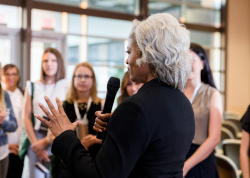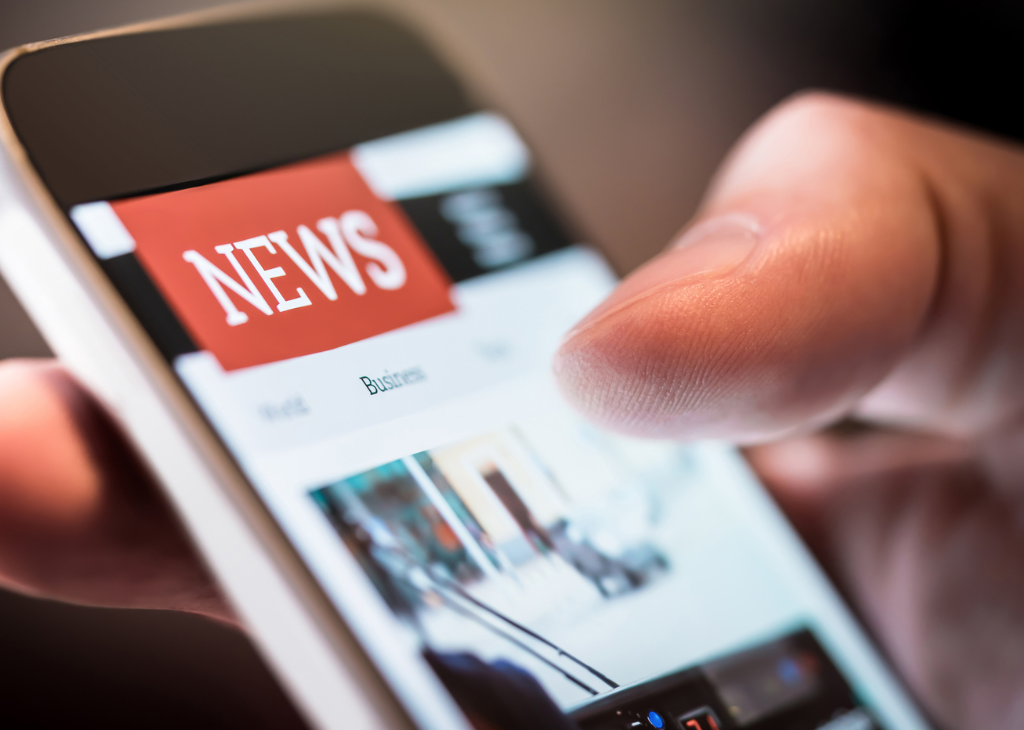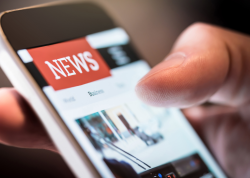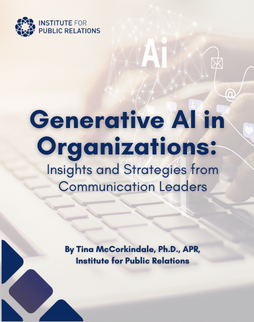 This blog is provided by the IPR Organizational Communication Research Center (OCRC)“Now more than ever, decision-makers can’t act alone; they must bring diverse perspectives to the table and ensure that those voices are fully heard” (Fletcher et al., 2023, para 2). Dissent originates from the Latin dissentire, meaning “feeling apart” (Kassing, 1997). “Dissent” in English means to “differ in opinion” (Merriam-Webster Dictionary). Dissent in the workplace refers to employees expressing disagreement, opposing viewpoints, or objections regarding various aspects of their work environment, including policies, practices, decisions, or actions taken by their organization or superiors. It involves employees speaking out in a manner that challenges the status quo or established norms. From an organizational communication perspective, dissent is primarily examined under the conceptual framework of employee voice and participation. In this tradition, dissent has been viewed as a form of employee voice that can enhance organizational learning and bring diverse perspectives into managerial decision-making. Under this approach, scholars have explored how organizations can foster a culture that can encourage a free flow of employee voice, including dissent, and establish organizational structures and policies that can facilitate employee empowerment. This has been done by examining factors that hinder employee voice and participation (e.g., silence or displaced dissent).Some communications managers may believe employee dissent harms internal organizational harmony and external reputation. This view is not entirely unwarranted, given how devastating media reports about disgruntled employees or former employees’ accounts of their experiences can tarnish the organizational reputation. My study, published in the Journal of Public Relations Research (Kang, 2021), precisely explored this question and found that negative testimonials significantly tarnished the organization’s moral and business reputations. However, dissent at the organizational level has many positive implications for the organization, and growth-oriented leaders consider dissent inherently legitimate and valuable for organizational learning capacities.Positive Implications of DissentDissent is a natural part of organizational politics and necessary for organizational democracy. Dissent as a voicerepresents the inherent right of employees to express their voice safely and openly in a democratic organization, as the concept of voice in the liberal political sense is considered a cornerstone of democratic society. Therefore, the value of dissent lies in the notion of voice as an inherently ethical and democratic thing for organizations to extend to their employees. From this perspective, employee dissent represents employee voice, which democratic organizations must practice earnestly, fostering open and decentralized organizational dynamics and culture. Dissent represents differences in values, opinions, and judgments instrumental to organizational learning and democracy. Dissent often exposes underlying conflicts or problems within the organization that can lead to the creation of collective solutions. When expressed constructively and within appropriate boundaries, dissent can bring new perspectives and alternative approaches to organizational problem-solving and decision-making. Thriving organizations allow diverse views and knowledge to be incorporated into organizational processes for effective problem identification, innovation and improvement, and decision-making.Employees often do not voice their discontent or dissent about workplace problems to their supervisors out of fear or futility. Instead, disgruntled employees may turn to ineffectual internal or external audiences to vent their frustrations or to make sense of the situation. This type of ineffectual dissent can catch management off guard and may lead to internal organizational turmoil and external reputational crisis. While the direct evidence linking organizational processes and dissent (beyond disruptive, displaced, and de-identified dissent) is lacking, we can extrapolate a positive relationship between dissent and supportive and democratic leadership and organizational processes. Also, studies have found that the organizational communication climate that fosters free speech influences how certain types of employee dissent prevail (e.g., Cenkci & Otken, 2019; West & Sacramento, 2023). To foster an organizational climate of psychological safety (Edmondson, 1999), relying on individual and interpersonal virtues of empathy and humility is not enough. Structural elements and organizational norms must be in place to safeguard the abuse of power in organizational processes and ensure democratic communication for effective organizational learning. For example, taking turns to speak up during a meeting can lessen the likelihood of a few influential voices dominating the conversation and provide the best outcome. Also, establishing protocols (norms) for expressing dissenting opinions can reduce the perils of group thinking and bring diverse perspectives to the surface by promoting dissent.How to Cultivate Dissent for Organizational Learning CapabilitiesCultivating an open climate for employee dissent requires deliberate actions and practices. Here are practical suggestions for creating such an environment:1.) First, create a culture of respectful dialogue by emphasizing the importance of respectful communication, even during disagreements. Encourage active listening, empathy, and understanding of differing perspectives. As part of this effort, diversity should be represented in decision-making teams, and leadership should demonstrate an excellent example of encouraging and valuing dissenting opinions.2.) Second, establish transparent decision-making protocols that incorporate dissent, such as soliciting diverse opinions, considering dissenting viewpoints, and outlining how decisions are reached. Establish regular feedback mechanisms and acknowledge that dissent can be a crucial part of the protocol.3.) Lastly, establish clear communication channels such as suggestion boxes, regular team meetings, anonymous feedback systems, or open-door policies to allow employees to express dissenting opinions without fear of reprisal.Dissent can be muted, ignored, reprimanded, expressed, and incorporated via formal and informal organizational channels. Employees can express their dissent in many ways through various stages of interactions within the organization. Dissent is more likely to occur as employees become more involved in organizational functions and are provided with routes to voice their input. In other words, dissent, in some ways, is a form of employee engagement and commitment to organizations.
This blog is provided by the IPR Organizational Communication Research Center (OCRC)“Now more than ever, decision-makers can’t act alone; they must bring diverse perspectives to the table and ensure that those voices are fully heard” (Fletcher et al., 2023, para 2). Dissent originates from the Latin dissentire, meaning “feeling apart” (Kassing, 1997). “Dissent” in English means to “differ in opinion” (Merriam-Webster Dictionary). Dissent in the workplace refers to employees expressing disagreement, opposing viewpoints, or objections regarding various aspects of their work environment, including policies, practices, decisions, or actions taken by their organization or superiors. It involves employees speaking out in a manner that challenges the status quo or established norms. From an organizational communication perspective, dissent is primarily examined under the conceptual framework of employee voice and participation. In this tradition, dissent has been viewed as a form of employee voice that can enhance organizational learning and bring diverse perspectives into managerial decision-making. Under this approach, scholars have explored how organizations can foster a culture that can encourage a free flow of employee voice, including dissent, and establish organizational structures and policies that can facilitate employee empowerment. This has been done by examining factors that hinder employee voice and participation (e.g., silence or displaced dissent).Some communications managers may believe employee dissent harms internal organizational harmony and external reputation. This view is not entirely unwarranted, given how devastating media reports about disgruntled employees or former employees’ accounts of their experiences can tarnish the organizational reputation. My study, published in the Journal of Public Relations Research (Kang, 2021), precisely explored this question and found that negative testimonials significantly tarnished the organization’s moral and business reputations. However, dissent at the organizational level has many positive implications for the organization, and growth-oriented leaders consider dissent inherently legitimate and valuable for organizational learning capacities.Positive Implications of DissentDissent is a natural part of organizational politics and necessary for organizational democracy. Dissent as a voicerepresents the inherent right of employees to express their voice safely and openly in a democratic organization, as the concept of voice in the liberal political sense is considered a cornerstone of democratic society. Therefore, the value of dissent lies in the notion of voice as an inherently ethical and democratic thing for organizations to extend to their employees. From this perspective, employee dissent represents employee voice, which democratic organizations must practice earnestly, fostering open and decentralized organizational dynamics and culture. Dissent represents differences in values, opinions, and judgments instrumental to organizational learning and democracy. Dissent often exposes underlying conflicts or problems within the organization that can lead to the creation of collective solutions. When expressed constructively and within appropriate boundaries, dissent can bring new perspectives and alternative approaches to organizational problem-solving and decision-making. Thriving organizations allow diverse views and knowledge to be incorporated into organizational processes for effective problem identification, innovation and improvement, and decision-making.Employees often do not voice their discontent or dissent about workplace problems to their supervisors out of fear or futility. Instead, disgruntled employees may turn to ineffectual internal or external audiences to vent their frustrations or to make sense of the situation. This type of ineffectual dissent can catch management off guard and may lead to internal organizational turmoil and external reputational crisis. While the direct evidence linking organizational processes and dissent (beyond disruptive, displaced, and de-identified dissent) is lacking, we can extrapolate a positive relationship between dissent and supportive and democratic leadership and organizational processes. Also, studies have found that the organizational communication climate that fosters free speech influences how certain types of employee dissent prevail (e.g., Cenkci & Otken, 2019; West & Sacramento, 2023). To foster an organizational climate of psychological safety (Edmondson, 1999), relying on individual and interpersonal virtues of empathy and humility is not enough. Structural elements and organizational norms must be in place to safeguard the abuse of power in organizational processes and ensure democratic communication for effective organizational learning. For example, taking turns to speak up during a meeting can lessen the likelihood of a few influential voices dominating the conversation and provide the best outcome. Also, establishing protocols (norms) for expressing dissenting opinions can reduce the perils of group thinking and bring diverse perspectives to the surface by promoting dissent.How to Cultivate Dissent for Organizational Learning CapabilitiesCultivating an open climate for employee dissent requires deliberate actions and practices. Here are practical suggestions for creating such an environment:1.) First, create a culture of respectful dialogue by emphasizing the importance of respectful communication, even during disagreements. Encourage active listening, empathy, and understanding of differing perspectives. As part of this effort, diversity should be represented in decision-making teams, and leadership should demonstrate an excellent example of encouraging and valuing dissenting opinions.2.) Second, establish transparent decision-making protocols that incorporate dissent, such as soliciting diverse opinions, considering dissenting viewpoints, and outlining how decisions are reached. Establish regular feedback mechanisms and acknowledge that dissent can be a crucial part of the protocol.3.) Lastly, establish clear communication channels such as suggestion boxes, regular team meetings, anonymous feedback systems, or open-door policies to allow employees to express dissenting opinions without fear of reprisal.Dissent can be muted, ignored, reprimanded, expressed, and incorporated via formal and informal organizational channels. Employees can express their dissent in many ways through various stages of interactions within the organization. Dissent is more likely to occur as employees become more involved in organizational functions and are provided with routes to voice their input. In other words, dissent, in some ways, is a form of employee engagement and commitment to organizations.
 Minjeong Kang, Ph. D. (Mass Communication, Syracuse University) is an associate professor at Indiana University. Dr Kang’s research has received national and international recognition, including Emerald Publishing’s Literati Award of Excellence for Highly Commended in 2018, Gallup Korea’s Outstanding Research Award in 2020, and the 2009 Ketchum Excellence in Public Relations Research Award by the Institute of Public Relations. Her recent work has focused on developing organizational listening diagnostics for participatory workplace communication and employee engagement.
...
Minjeong Kang, Ph. D. (Mass Communication, Syracuse University) is an associate professor at Indiana University. Dr Kang’s research has received national and international recognition, including Emerald Publishing’s Literati Award of Excellence for Highly Commended in 2018, Gallup Korea’s Outstanding Research Award in 2020, and the 2009 Ketchum Excellence in Public Relations Research Award by the Institute of Public Relations. Her recent work has focused on developing organizational listening diagnostics for participatory workplace communication and employee engagement.
...
Read More...

 Fortune and Deloitte examined the top challenges that CEOs are currently facing and their perceptions on the global economy.Fortune and Deloitte surveyed CEOs from the Fortune 500, Fortune Global 500, and other select executives from Feb. 13–23, 2024.Key findings include:1.) 65% of CEOs felt geopolitical concerns, most specifically the U.S. election, are one of the three most significant disruptors they expect to face over the coming 12 months, up from 51% in the last survey.2.) 56% of CEOs said their companies are using generative AI to make their companies more efficient.3.) 24% of CEOs said they are pessimistic about the economy over the next 12 months.4.) 22% of CEOs said they are very optimistic about the economy over the next 12 months, an increase from 10% in October 2023.Read about current challenges for CEOs and more
...
Fortune and Deloitte examined the top challenges that CEOs are currently facing and their perceptions on the global economy.Fortune and Deloitte surveyed CEOs from the Fortune 500, Fortune Global 500, and other select executives from Feb. 13–23, 2024.Key findings include:1.) 65% of CEOs felt geopolitical concerns, most specifically the U.S. election, are one of the three most significant disruptors they expect to face over the coming 12 months, up from 51% in the last survey.2.) 56% of CEOs said their companies are using generative AI to make their companies more efficient.3.) 24% of CEOs said they are pessimistic about the economy over the next 12 months.4.) 22% of CEOs said they are very optimistic about the economy over the next 12 months, an increase from 10% in October 2023.Read about current challenges for CEOs and more
... 
 This blog is provided by the IPR Organizational Communication Research Center (OCRC)“Now more than ever, decision-makers can’t act alone; they must bring diverse perspectives to the table and ensure that those voices are fully heard” (Fletcher et al., 2023, para 2). Dissent originates from the Latin dissentire, meaning “feeling apart” (Kassing, 1997). “Dissent” in English means to “differ in opinion” (Merriam-Webster Dictionary). Dissent in the workplace refers to employees expressing disagreement, opposing viewpoints, or objections regarding various aspects of their work environment, including policies, practices, decisions, or actions taken by their organization or superiors. It involves employees speaking out in a manner that challenges the status quo or established norms. From an organizational communication perspective, dissent is primarily examined under the conceptual framework of employee voice and participation. In this tradition, dissent has been viewed as a form of employee voice that can enhance organizational learning and bring diverse perspectives into managerial decision-making. Under this approach, scholars have explored how organizations can foster a culture that can encourage a free flow of employee voice, including dissent, and establish organizational structures and policies that can facilitate employee empowerment. This has been done by examining factors that hinder employee voice and participation (e.g., silence or displaced dissent).Some communications managers may believe employee dissent harms internal organizational harmony and external reputation. This view is not entirely unwarranted, given how devastating media reports about disgruntled employees or former employees’ accounts of their experiences can tarnish the organizational reputation. My study, published in the Journal of Public Relations Research (Kang, 2021), precisely explored this question and found that negative testimonials significantly tarnished the organization’s moral and business reputations. However, dissent at the organizational level has many positive implications for the organization, and growth-oriented leaders consider dissent inherently legitimate and valuable for organizational learning capacities.Positive Implications of DissentDissent is a natural part of organizational politics and necessary for organizational democracy. Dissent as a voicerepresents the inherent right of employees to express their voice safely and openly in a democratic organization, as the concept of voice in the liberal political sense is considered a cornerstone of democratic society. Therefore, the value of dissent lies in the notion of voice as an inherently ethical and democratic thing for organizations to extend to their employees. From this perspective, employee dissent represents employee voice, which democratic organizations must practice earnestly, fostering open and decentralized organizational dynamics and culture. Dissent represents differences in values, opinions, and judgments instrumental to organizational learning and democracy. Dissent often exposes underlying conflicts or problems within the organization that can lead to the creation of collective solutions. When expressed constructively and within appropriate boundaries, dissent can bring new perspectives and alternative approaches to organizational problem-solving and decision-making. Thriving organizations allow diverse views and knowledge to be incorporated into organizational processes for effective problem identification, innovation and improvement, and decision-making.Employees often do not voice their discontent or dissent about workplace problems to their supervisors out of fear or futility. Instead, disgruntled employees may turn to ineffectual internal or external audiences to vent their frustrations or to make sense of the situation. This type of ineffectual dissent can catch management off guard and may lead to internal organizational turmoil and external reputational crisis. While the direct evidence linking organizational processes and dissent (beyond disruptive, displaced, and de-identified dissent) is lacking, we can extrapolate a positive relationship between dissent and supportive and democratic leadership and organizational processes. Also, studies have found that the organizational communication climate that fosters free speech influences how certain types of employee dissent prevail (e.g., Cenkci & Otken, 2019; West & Sacramento, 2023). To foster an organizational climate of psychological safety (Edmondson, 1999), relying on individual and interpersonal virtues of empathy and humility is not enough. Structural elements and organizational norms must be in place to safeguard the abuse of power in organizational processes and ensure democratic communication for effective organizational learning. For example, taking turns to speak up during a meeting can lessen the likelihood of a few influential voices dominating the conversation and provide the best outcome. Also, establishing protocols (norms) for expressing dissenting opinions can reduce the perils of group thinking and bring diverse perspectives to the surface by promoting dissent.How to Cultivate Dissent for Organizational Learning CapabilitiesCultivating an open climate for employee dissent requires deliberate actions and practices. Here are practical suggestions for creating such an environment:1.) First, create a culture of respectful dialogue by emphasizing the importance of respectful communication, even during disagreements. Encourage active listening, empathy, and understanding of differing perspectives. As part of this effort, diversity should be represented in decision-making teams, and leadership should demonstrate an excellent example of encouraging and valuing dissenting opinions.2.) Second, establish transparent decision-making protocols that incorporate dissent, such as soliciting diverse opinions, considering dissenting viewpoints, and outlining how decisions are reached. Establish regular feedback mechanisms and acknowledge that dissent can be a crucial part of the protocol.3.) Lastly, establish clear communication channels such as suggestion boxes, regular team meetings, anonymous feedback systems, or open-door policies to allow employees to express dissenting opinions without fear of reprisal.Dissent can be muted, ignored, reprimanded, expressed, and incorporated via formal and informal organizational channels. Employees can express their dissent in many ways through various stages of interactions within the organization. Dissent is more likely to occur as employees become more involved in organizational functions and are provided with routes to voice their input. In other words, dissent, in some ways, is a form of employee engagement and commitment to organizations.
This blog is provided by the IPR Organizational Communication Research Center (OCRC)“Now more than ever, decision-makers can’t act alone; they must bring diverse perspectives to the table and ensure that those voices are fully heard” (Fletcher et al., 2023, para 2). Dissent originates from the Latin dissentire, meaning “feeling apart” (Kassing, 1997). “Dissent” in English means to “differ in opinion” (Merriam-Webster Dictionary). Dissent in the workplace refers to employees expressing disagreement, opposing viewpoints, or objections regarding various aspects of their work environment, including policies, practices, decisions, or actions taken by their organization or superiors. It involves employees speaking out in a manner that challenges the status quo or established norms. From an organizational communication perspective, dissent is primarily examined under the conceptual framework of employee voice and participation. In this tradition, dissent has been viewed as a form of employee voice that can enhance organizational learning and bring diverse perspectives into managerial decision-making. Under this approach, scholars have explored how organizations can foster a culture that can encourage a free flow of employee voice, including dissent, and establish organizational structures and policies that can facilitate employee empowerment. This has been done by examining factors that hinder employee voice and participation (e.g., silence or displaced dissent).Some communications managers may believe employee dissent harms internal organizational harmony and external reputation. This view is not entirely unwarranted, given how devastating media reports about disgruntled employees or former employees’ accounts of their experiences can tarnish the organizational reputation. My study, published in the Journal of Public Relations Research (Kang, 2021), precisely explored this question and found that negative testimonials significantly tarnished the organization’s moral and business reputations. However, dissent at the organizational level has many positive implications for the organization, and growth-oriented leaders consider dissent inherently legitimate and valuable for organizational learning capacities.Positive Implications of DissentDissent is a natural part of organizational politics and necessary for organizational democracy. Dissent as a voicerepresents the inherent right of employees to express their voice safely and openly in a democratic organization, as the concept of voice in the liberal political sense is considered a cornerstone of democratic society. Therefore, the value of dissent lies in the notion of voice as an inherently ethical and democratic thing for organizations to extend to their employees. From this perspective, employee dissent represents employee voice, which democratic organizations must practice earnestly, fostering open and decentralized organizational dynamics and culture. Dissent represents differences in values, opinions, and judgments instrumental to organizational learning and democracy. Dissent often exposes underlying conflicts or problems within the organization that can lead to the creation of collective solutions. When expressed constructively and within appropriate boundaries, dissent can bring new perspectives and alternative approaches to organizational problem-solving and decision-making. Thriving organizations allow diverse views and knowledge to be incorporated into organizational processes for effective problem identification, innovation and improvement, and decision-making.Employees often do not voice their discontent or dissent about workplace problems to their supervisors out of fear or futility. Instead, disgruntled employees may turn to ineffectual internal or external audiences to vent their frustrations or to make sense of the situation. This type of ineffectual dissent can catch management off guard and may lead to internal organizational turmoil and external reputational crisis. While the direct evidence linking organizational processes and dissent (beyond disruptive, displaced, and de-identified dissent) is lacking, we can extrapolate a positive relationship between dissent and supportive and democratic leadership and organizational processes. Also, studies have found that the organizational communication climate that fosters free speech influences how certain types of employee dissent prevail (e.g., Cenkci & Otken, 2019; West & Sacramento, 2023). To foster an organizational climate of psychological safety (Edmondson, 1999), relying on individual and interpersonal virtues of empathy and humility is not enough. Structural elements and organizational norms must be in place to safeguard the abuse of power in organizational processes and ensure democratic communication for effective organizational learning. For example, taking turns to speak up during a meeting can lessen the likelihood of a few influential voices dominating the conversation and provide the best outcome. Also, establishing protocols (norms) for expressing dissenting opinions can reduce the perils of group thinking and bring diverse perspectives to the surface by promoting dissent.How to Cultivate Dissent for Organizational Learning CapabilitiesCultivating an open climate for employee dissent requires deliberate actions and practices. Here are practical suggestions for creating such an environment:1.) First, create a culture of respectful dialogue by emphasizing the importance of respectful communication, even during disagreements. Encourage active listening, empathy, and understanding of differing perspectives. As part of this effort, diversity should be represented in decision-making teams, and leadership should demonstrate an excellent example of encouraging and valuing dissenting opinions.2.) Second, establish transparent decision-making protocols that incorporate dissent, such as soliciting diverse opinions, considering dissenting viewpoints, and outlining how decisions are reached. Establish regular feedback mechanisms and acknowledge that dissent can be a crucial part of the protocol.3.) Lastly, establish clear communication channels such as suggestion boxes, regular team meetings, anonymous feedback systems, or open-door policies to allow employees to express dissenting opinions without fear of reprisal.Dissent can be muted, ignored, reprimanded, expressed, and incorporated via formal and informal organizational channels. Employees can express their dissent in many ways through various stages of interactions within the organization. Dissent is more likely to occur as employees become more involved in organizational functions and are provided with routes to voice their input. In other words, dissent, in some ways, is a form of employee engagement and commitment to organizations.
 Minjeong Kang, Ph. D. (Mass Communication, Syracuse University) is an associate professor at Indiana University. Dr Kang’s research has received national and international recognition, including Emerald Publishing’s Literati Award of Excellence for Highly Commended in 2018, Gallup Korea’s Outstanding Research Award in 2020, and the 2009 Ketchum Excellence in Public Relations Research Award by the Institute of Public Relations. Her recent work has focused on developing organizational listening diagnostics for participatory workplace communication and employee engagement.
...
Minjeong Kang, Ph. D. (Mass Communication, Syracuse University) is an associate professor at Indiana University. Dr Kang’s research has received national and international recognition, including Emerald Publishing’s Literati Award of Excellence for Highly Commended in 2018, Gallup Korea’s Outstanding Research Award in 2020, and the 2009 Ketchum Excellence in Public Relations Research Award by the Institute of Public Relations. Her recent work has focused on developing organizational listening diagnostics for participatory workplace communication and employee engagement.
... 
 Weber Shandwick and KRC Research examined American consumer and employee opinions on the role businesses play in national elections.An online survey of 1,009 U.S. adults was conducted from February 9–12, 2024.Key findings include:1.) 44% of respondents somewhat agreed with the statement that “businesses are a constructive force for positive change.”— 25% of respondents strongly agreed with that statement.2.) 75% of employees and 68% of consumers said “businesses should help find common ground to bridge societal decisions.” 3.) 72% of consumers and 71% of employees said “the workplace should be kept politically neutral during this election year.”4.) 81% of employees and 80% of consumers said “American businesses should encourage a free and fair election.”5.) 25% of employees and 23% of consumers said American businesses should endorse candidates.Read more about American businesses involvement in politics
...
Weber Shandwick and KRC Research examined American consumer and employee opinions on the role businesses play in national elections.An online survey of 1,009 U.S. adults was conducted from February 9–12, 2024.Key findings include:1.) 44% of respondents somewhat agreed with the statement that “businesses are a constructive force for positive change.”— 25% of respondents strongly agreed with that statement.2.) 75% of employees and 68% of consumers said “businesses should help find common ground to bridge societal decisions.” 3.) 72% of consumers and 71% of employees said “the workplace should be kept politically neutral during this election year.”4.) 81% of employees and 80% of consumers said “American businesses should encourage a free and fair election.”5.) 25% of employees and 23% of consumers said American businesses should endorse candidates.Read more about American businesses involvement in politics
... 
 Alethea examined how disinformation tactics are being used in social media to influence individuals. Specifically, Alethea studied X (formerly Twitter) accounts that they believed were being leveraged by Russia’s main military intelligence directorate to influence U.S. citizens on the war in Ukraine.Alethea analyzed 5,314 accounts on X (formerly Twitter) and 81 websites that the company believed were being used by a Russian military intelligence directorate, commonly known as the GRU, in February – March 2024. Accounts were classified in two ways:— “Poster” accounts that create content— “Amplifier” accounts from the same group that repost poster accounts or quote “poster” account contentKey findings include:1.) Amplifier accounts used the “Invisible Ink” technique (re-sharing poster account content without additional text) to amplify “poster” account content in reply threads in order to go undetected.2.) At least 50 accounts shared original posts in English about U.S. domestic and foreign policy containing images and external links.3.) Despite the fact that a majority of these accounts had zero followers and only published one or two total posts, the posts by poster accounts consistently received approximately 1,300 or 2,600 reposts and over 5,000 views, which is a result of of inauthentic amplification.4.) At least five accounts shared original posts about foreign and domestic policy in a mix of English, French, German, and Ukrainian.
Alethea examined how disinformation tactics are being used in social media to influence individuals. Specifically, Alethea studied X (formerly Twitter) accounts that they believed were being leveraged by Russia’s main military intelligence directorate to influence U.S. citizens on the war in Ukraine.Alethea analyzed 5,314 accounts on X (formerly Twitter) and 81 websites that the company believed were being used by a Russian military intelligence directorate, commonly known as the GRU, in February – March 2024. Accounts were classified in two ways:— “Poster” accounts that create content— “Amplifier” accounts from the same group that repost poster accounts or quote “poster” account contentKey findings include:1.) Amplifier accounts used the “Invisible Ink” technique (re-sharing poster account content without additional text) to amplify “poster” account content in reply threads in order to go undetected.2.) At least 50 accounts shared original posts in English about U.S. domestic and foreign policy containing images and external links.3.) Despite the fact that a majority of these accounts had zero followers and only published one or two total posts, the posts by poster accounts consistently received approximately 1,300 or 2,600 reposts and over 5,000 views, which is a result of of inauthentic amplification.4.) At least five accounts shared original posts about foreign and domestic policy in a mix of English, French, German, and Ukrainian.
 Continue reading more on the hidden influence of GRU operatives
...
Continue reading more on the hidden influence of GRU operatives
... 
 This summary is provided by the IPR Digital Media Research CenterVictoria Oldemburgo de Mello, Dr. Felix Cheung, and Dr. Michael Inzlicht analyzed how X impacts user well-being, political polarization, outrage, and sense of belonging.A survey of 309 X users was conducted from March – June 2021.Key findings include:1.) Respondents said they used the platform for entertainment (66%), followed by information seeking (49%), and to interact with others (23%).2.) Different actions on X predicted behavior outcomes:— “Scrolling down the feed” predicted a decrease in well-being.— “Replying to others’ tweets,” “visiting trending topics,” and “visiting others’ profiles” predicted an increase in a “sense of belonging.”— “Retweeting” predicted an increase in polarization.3.) X use was related to overall decreases in well-being and increases in a sense of belonging, polarization, outrage, and boredom.4.) Users who frequented the platform were found to be “lonelier” and “more bored.”— Users who frequently retweeted content were found to be “more polarized.”Learn more about how X affects user well-being and emotional wellness
...
This summary is provided by the IPR Digital Media Research CenterVictoria Oldemburgo de Mello, Dr. Felix Cheung, and Dr. Michael Inzlicht analyzed how X impacts user well-being, political polarization, outrage, and sense of belonging.A survey of 309 X users was conducted from March – June 2021.Key findings include:1.) Respondents said they used the platform for entertainment (66%), followed by information seeking (49%), and to interact with others (23%).2.) Different actions on X predicted behavior outcomes:— “Scrolling down the feed” predicted a decrease in well-being.— “Replying to others’ tweets,” “visiting trending topics,” and “visiting others’ profiles” predicted an increase in a “sense of belonging.”— “Retweeting” predicted an increase in polarization.3.) X use was related to overall decreases in well-being and increases in a sense of belonging, polarization, outrage, and boredom.4.) Users who frequented the platform were found to be “lonelier” and “more bored.”— Users who frequently retweeted content were found to be “more polarized.”Learn more about how X affects user well-being and emotional wellness
... 
 Muck Rack analyzed current trends in journalism, including concerns about funding and trust, employment practices, and the implementation of generative AI.An online survey of 1,106 U.S. journalists was conducted Jan. 3 – Feb. 9, 2024.Key findings include:1.) 28% of journalists said they currently use generative AI, followed by 20% who plan to explore its uses in journalism.2.) 45% said their does not have an AI use case policy, compared to 24% who said their company does have a policy in place.3.) 70% of journalists said public relations professionals were at least “moderately important” to their success.4.) Journalists’ top concerns currently include a lack of funding (35%), trust in journalism/media (31%), disinformation (28%), and the decline in local news (24%).5.) 69% said digital publication is the primary medium for their work, followed by print (19%), and TV (4%). Read more about current concerns and trends in the journalism industry
...
Muck Rack analyzed current trends in journalism, including concerns about funding and trust, employment practices, and the implementation of generative AI.An online survey of 1,106 U.S. journalists was conducted Jan. 3 – Feb. 9, 2024.Key findings include:1.) 28% of journalists said they currently use generative AI, followed by 20% who plan to explore its uses in journalism.2.) 45% said their does not have an AI use case policy, compared to 24% who said their company does have a policy in place.3.) 70% of journalists said public relations professionals were at least “moderately important” to their success.4.) Journalists’ top concerns currently include a lack of funding (35%), trust in journalism/media (31%), disinformation (28%), and the decline in local news (24%).5.) 69% said digital publication is the primary medium for their work, followed by print (19%), and TV (4%). Read more about current concerns and trends in the journalism industry
... 
 This summary is provided by the IPR Digital Media Research CenterDr. Yuan Sun, Dr. Jin Chen, and Dr. S. Shyam Sundar analyzed AI chatbots’ capability to simulate human-like conversations and whether they are more persuasive when they appear human-like in their appearance, interactions, and delivery of advertising content.An online experiment with 414 adult respondents was conducted from Jan. 10–14, 2021. The participants interacted with either human-like chatbot profiles or machine-like chatbot profiles. Participants were also presented with narrative ads (ads “similar to human ‘storytellers’ which conveyed key messages through stories”) or factual ads (ads which “delivered product details and statistical evidence in a manner that would be consistent with a machine-like presenter”).Key findings include:1.) When respondents were able to interact with the chatbot, their attitudes toward the advertisement were more likely to be positive.— Greater interactivity also led to increased behavioral intention with the advertised product.2.) Narrative ads enhanced consumer engagement and reduced respondents’ awareness of the advertiser’s intent to persuade.3.) Narrative ads from interactive, machine-like chatbots generated the most positive attitudes toward advertisements.4.) Factual ads from less interactive, human-like chatbots generated the least positive attitudes toward advertisements.Learn more about different types of chatbots and their influence on consumers
...
This summary is provided by the IPR Digital Media Research CenterDr. Yuan Sun, Dr. Jin Chen, and Dr. S. Shyam Sundar analyzed AI chatbots’ capability to simulate human-like conversations and whether they are more persuasive when they appear human-like in their appearance, interactions, and delivery of advertising content.An online experiment with 414 adult respondents was conducted from Jan. 10–14, 2021. The participants interacted with either human-like chatbot profiles or machine-like chatbot profiles. Participants were also presented with narrative ads (ads “similar to human ‘storytellers’ which conveyed key messages through stories”) or factual ads (ads which “delivered product details and statistical evidence in a manner that would be consistent with a machine-like presenter”).Key findings include:1.) When respondents were able to interact with the chatbot, their attitudes toward the advertisement were more likely to be positive.— Greater interactivity also led to increased behavioral intention with the advertised product.2.) Narrative ads enhanced consumer engagement and reduced respondents’ awareness of the advertiser’s intent to persuade.3.) Narrative ads from interactive, machine-like chatbots generated the most positive attitudes toward advertisements.4.) Factual ads from less interactive, human-like chatbots generated the least positive attitudes toward advertisements.Learn more about different types of chatbots and their influence on consumers
... 
 Updated March 8, 2024
Thanks to the IPR Digital Media Research Center team for their considerations and input.
With the increased use of generative AI and the potential for increased misinformation and decreased transparency in the research space, the Institute for Public Relations (IPR) has created a disclosure policy for labeling generative AI use in research-related content. Content labels help prevent disinformation, allow transparency for material sources, and help prevent plagiarism. This ensures openness, accountability, honesty, and rigor of the material that IPR creates and publishes. Considerations When Using Generative AI● Generative AI cannot verify the quality or accuracy of the work it draws upon and is prone to hallucinations (or making up content). ● Generative AI output may contain biased information.● Generative AI stops collecting information at a certain period of time, so it does not use the most updated research or material. ● Confidential or proprietary information should not be uploaded or fed to generative AI (including the responses of participants who have requested confidentiality or anonymity).Therefore, IPR requires in-text disclosures of substantive generative AI use in its research-related materials. The research materials that require disclosure include:● Blogs, blurbs, and research summaries● IPR Research Letter articles● IPR Signature Studies● Public Relations Journal articles● IPR Deconstructing series articles● Presentation materials at IPR events or programsRules and Guidelines for AI Use in IPR-Published Work● Authors must disclose how generative AI was used and to what extent. ● Generative AI should be used primarily for editorial assistance. AI should not be used as a co-author for a research paper, as it cannot take responsibility for the work. ● Authors and creators must take full responsibility for all content created by generative AI, including the use of copyrighted material, and ensure the content is factual, credible, accurate, and supported by other reliable sources. ● AI should not be used as a primary or secondary source. Instead, it is the author’s responsibility to track original content sources for proper attribution. ● Each use of generative AI within a document should be addressed individually.● Authors are responsible for complying with relevant laws and regulations related to AI-generated content.Generative AI use should be labeled or disclosed when used for:● The research process, such as collecting or analyzing the data● New content generation (visual or written)● Content a reader would assume to be human-created● Language translation (content should also be checked by a fluent speaker)● Editing that changes the style, voice, or composition of the writingGenerative AI typically does not require a label or disclosure for:● Idea or topic generation/brainstorming● Grammatical changes or other minor edits that do not change the overall content, style, or voice of the piece● Summarizing of material if it does not change the contentWays to disclose:● In-text citation using APA style● A reference in a paragraph in the report● Footnote● EndnoteWhat should be included in the label or disclosure:● The generative AI program used (e.g., ChatGPT 4.0)● The prompt used (e.g., summarize these research findings in two paragraphs)● The section where generative AI was applied (e.g., introduction)● Who used the generative AI (e.g., Dr. Tina McCorkindale)● The date, if applicableHere is an example of a footnote: The introduction was created by inserting the bulk of the report written solely by Dr. McCorkindale, the primary author of this report, into ChatGPT 4 and then asking it to create two introductory paragraphs. Dr. McCorkindale checked the accuracy of the content and edited the introduction.For more information about content disclosure, please refer to Dr. Cayce Myers’s IPR article, “To disclose or not to disclose: That is the AI question.” IPR suggests that if in doubt whether AI-generated content should be labeled, it’s best to over-disclose rather than under-disclose.Please note: This policy will evolve to ensure it remains relevant and effective throughout changes in the AI disclosure landscape.
...
Updated March 8, 2024
Thanks to the IPR Digital Media Research Center team for their considerations and input.
With the increased use of generative AI and the potential for increased misinformation and decreased transparency in the research space, the Institute for Public Relations (IPR) has created a disclosure policy for labeling generative AI use in research-related content. Content labels help prevent disinformation, allow transparency for material sources, and help prevent plagiarism. This ensures openness, accountability, honesty, and rigor of the material that IPR creates and publishes. Considerations When Using Generative AI● Generative AI cannot verify the quality or accuracy of the work it draws upon and is prone to hallucinations (or making up content). ● Generative AI output may contain biased information.● Generative AI stops collecting information at a certain period of time, so it does not use the most updated research or material. ● Confidential or proprietary information should not be uploaded or fed to generative AI (including the responses of participants who have requested confidentiality or anonymity).Therefore, IPR requires in-text disclosures of substantive generative AI use in its research-related materials. The research materials that require disclosure include:● Blogs, blurbs, and research summaries● IPR Research Letter articles● IPR Signature Studies● Public Relations Journal articles● IPR Deconstructing series articles● Presentation materials at IPR events or programsRules and Guidelines for AI Use in IPR-Published Work● Authors must disclose how generative AI was used and to what extent. ● Generative AI should be used primarily for editorial assistance. AI should not be used as a co-author for a research paper, as it cannot take responsibility for the work. ● Authors and creators must take full responsibility for all content created by generative AI, including the use of copyrighted material, and ensure the content is factual, credible, accurate, and supported by other reliable sources. ● AI should not be used as a primary or secondary source. Instead, it is the author’s responsibility to track original content sources for proper attribution. ● Each use of generative AI within a document should be addressed individually.● Authors are responsible for complying with relevant laws and regulations related to AI-generated content.Generative AI use should be labeled or disclosed when used for:● The research process, such as collecting or analyzing the data● New content generation (visual or written)● Content a reader would assume to be human-created● Language translation (content should also be checked by a fluent speaker)● Editing that changes the style, voice, or composition of the writingGenerative AI typically does not require a label or disclosure for:● Idea or topic generation/brainstorming● Grammatical changes or other minor edits that do not change the overall content, style, or voice of the piece● Summarizing of material if it does not change the contentWays to disclose:● In-text citation using APA style● A reference in a paragraph in the report● Footnote● EndnoteWhat should be included in the label or disclosure:● The generative AI program used (e.g., ChatGPT 4.0)● The prompt used (e.g., summarize these research findings in two paragraphs)● The section where generative AI was applied (e.g., introduction)● Who used the generative AI (e.g., Dr. Tina McCorkindale)● The date, if applicableHere is an example of a footnote: The introduction was created by inserting the bulk of the report written solely by Dr. McCorkindale, the primary author of this report, into ChatGPT 4 and then asking it to create two introductory paragraphs. Dr. McCorkindale checked the accuracy of the content and edited the introduction.For more information about content disclosure, please refer to Dr. Cayce Myers’s IPR article, “To disclose or not to disclose: That is the AI question.” IPR suggests that if in doubt whether AI-generated content should be labeled, it’s best to over-disclose rather than under-disclose.Please note: This policy will evolve to ensure it remains relevant and effective throughout changes in the AI disclosure landscape.
... 
 This IPR Signature Study is provided by the IPR Center for Diversity, Equity, and InclusionThrough interviews with 20 Chief Diversity Officers and 20 Chief Communications Officers conducted in 2023, “Collaborators for Change: Researching the Relationship between the Chief Communications Officer and the Chief Diversity Officer and the Role of DEI in the Workplace” examines the impact, influence, and importance of the CDO position, and the dynamics between these key executives in driving organizational change.
Five key findings:Origin of the CDO Role: All Chief Diversity Officers (CDOs) had prior diversity-related experience predating the formalization of the CDO position, with an increase in involvement following George Floyd’s murder.“Technically, I had been doing this work long before I had the title…I’ve been representing (the organization) and building our diversity program and platform for many years. However, it was in 2020 when the tragedy of George Floyd occurred, and Breonna [Taylor] and so many others, I sat down (with the founder) and we talked about our level of commitment to DEI. We decided we needed to make this an all-agency, all-hands-on-deck emergency SOS and I was asked to lead our efforts. We created a global committee of over 100 employees around the world that got together and said, ‘This is not just a Black and White issue, this is an issue of humanity, and we need to all take a stand and make a difference.’” -CDO, global marketing agencyDEI Prioritization: George Floyd’s murder catalyzed a focus on Diversity, Equity, and Inclusion (DEI) efforts, making DEI in the top 10 priorities for nearly all organizations that participated in this study.“It’s top 10, and it’s probably right on the cusp, creeping into the top five. I would like to see it prioritized a bit more in the context of where we are as a business and as an organization. We’re going through a bit of a transformation right now. And so, oftentimes, when organizations are going through that, DEI gets deprioritized a little bit. I don’t feel like it’s been completely deprioritized, but I do feel that we’re continuing to try to remind leaders that you don’t only focus on DEI when things are going well. If the business is challenged, it’s actually when you really need to have a strategic and intentional focus on DEI because it’s a lever and a driver for your business.” -CDO, global retail companyReporting Structures: There’s a consensus among CDOs and CCOs for the CDO role to be a stand-alone, executive position, preferably reporting to the CEO, although some organizations opt for reporting to the Chief Human Resources Officer.“The way it works here I think is really powerful. Our CDO reports directly to the president of the university and sits as a member of the senior most executive leadership team. I think that’s the ideal place. If we could make it a more high-profile reporting relationship, I’d say we should, but you don’t get much more high-profile than reporting to the chief executive of the institution.” -CCO, private universityOptimism Despite Challenges: CDOs face a number of challenges including overwork, limited resources, and DEI fatigue, yet both CDOs and CCOs express cautious optimism about the future of DEI efforts and their working relationships.“I’m really hoping that we can find a language that unites people in talking about the need of equalizing the grounds of opportunities for all the people, not just in higher ed, but in our country. That needs to happen. Access to food, access to education, access to clean air. And I’m hopeful that this forces us to dismantle what we know, then we can mourn, and we can get over it and really find something that works for everybody. Because we cannot pretend like these things are not here. You can call it whatever you want. I want the recognition and the proactiveness to do something to change this for our next generations. We cannot ignore these things as if they don’t exist.” -vice provost, DEI, public universityThe Relationship with the CCO: CDOs and CCOs view each other as allies in communicating the results and impact DEI initiatives have on the organization. “You need a network of communicators who are fully invested in telling the narrative around this topic, and to understand how it shows up in the business, even when it’s not being called DEI. If you think about the segmentation of your customers and the demographics of your company, the diversity of your products, and your innovations, and the reasons why those innovations either unfolded or took hold, the basis of it was about the diversity of thought and creativity.” -head of development, national financial services institution
This IPR Signature Study is provided by the IPR Center for Diversity, Equity, and InclusionThrough interviews with 20 Chief Diversity Officers and 20 Chief Communications Officers conducted in 2023, “Collaborators for Change: Researching the Relationship between the Chief Communications Officer and the Chief Diversity Officer and the Role of DEI in the Workplace” examines the impact, influence, and importance of the CDO position, and the dynamics between these key executives in driving organizational change.
Five key findings:Origin of the CDO Role: All Chief Diversity Officers (CDOs) had prior diversity-related experience predating the formalization of the CDO position, with an increase in involvement following George Floyd’s murder.“Technically, I had been doing this work long before I had the title…I’ve been representing (the organization) and building our diversity program and platform for many years. However, it was in 2020 when the tragedy of George Floyd occurred, and Breonna [Taylor] and so many others, I sat down (with the founder) and we talked about our level of commitment to DEI. We decided we needed to make this an all-agency, all-hands-on-deck emergency SOS and I was asked to lead our efforts. We created a global committee of over 100 employees around the world that got together and said, ‘This is not just a Black and White issue, this is an issue of humanity, and we need to all take a stand and make a difference.’” -CDO, global marketing agencyDEI Prioritization: George Floyd’s murder catalyzed a focus on Diversity, Equity, and Inclusion (DEI) efforts, making DEI in the top 10 priorities for nearly all organizations that participated in this study.“It’s top 10, and it’s probably right on the cusp, creeping into the top five. I would like to see it prioritized a bit more in the context of where we are as a business and as an organization. We’re going through a bit of a transformation right now. And so, oftentimes, when organizations are going through that, DEI gets deprioritized a little bit. I don’t feel like it’s been completely deprioritized, but I do feel that we’re continuing to try to remind leaders that you don’t only focus on DEI when things are going well. If the business is challenged, it’s actually when you really need to have a strategic and intentional focus on DEI because it’s a lever and a driver for your business.” -CDO, global retail companyReporting Structures: There’s a consensus among CDOs and CCOs for the CDO role to be a stand-alone, executive position, preferably reporting to the CEO, although some organizations opt for reporting to the Chief Human Resources Officer.“The way it works here I think is really powerful. Our CDO reports directly to the president of the university and sits as a member of the senior most executive leadership team. I think that’s the ideal place. If we could make it a more high-profile reporting relationship, I’d say we should, but you don’t get much more high-profile than reporting to the chief executive of the institution.” -CCO, private universityOptimism Despite Challenges: CDOs face a number of challenges including overwork, limited resources, and DEI fatigue, yet both CDOs and CCOs express cautious optimism about the future of DEI efforts and their working relationships.“I’m really hoping that we can find a language that unites people in talking about the need of equalizing the grounds of opportunities for all the people, not just in higher ed, but in our country. That needs to happen. Access to food, access to education, access to clean air. And I’m hopeful that this forces us to dismantle what we know, then we can mourn, and we can get over it and really find something that works for everybody. Because we cannot pretend like these things are not here. You can call it whatever you want. I want the recognition and the proactiveness to do something to change this for our next generations. We cannot ignore these things as if they don’t exist.” -vice provost, DEI, public universityThe Relationship with the CCO: CDOs and CCOs view each other as allies in communicating the results and impact DEI initiatives have on the organization. “You need a network of communicators who are fully invested in telling the narrative around this topic, and to understand how it shows up in the business, even when it’s not being called DEI. If you think about the segmentation of your customers and the demographics of your company, the diversity of your products, and your innovations, and the reasons why those innovations either unfolded or took hold, the basis of it was about the diversity of thought and creativity.” -head of development, national financial services institution

 This report is provided by the IPR Digital Media Research CenterIn, “Generative AI in Organizations: Insights and Strategies from Communication Leaders,” the Institute for Public Relations (IPR) conducted interviews from November 2023 to January 2024 with 30 communication executives, chief communication officers (CCOs), agency CEOs, academics, and leaders to examine how generative AI is impacting their function and organization. This report specifically examines the role of AI tools like ChatGPT, Microsoft Copilot, DALL-E, and others, probing how they are shaping communication and marketing strategies.
Topics covered in this report include:— What is generative AI?— Comfortability of communication leaders with generative AI— Comfortability of organizational Leaders with AI— Ownership of AI in organizations— Concerns about generative AI— AI guidelines and frameworks— Impact on communications function— How communicators are using generative AI— AI training and professional development— What communicators need to know— Impact of generative AI on the business— Who to follow— Tips and prompts
Based on the interviews with the 30 communication and technology leaders, the following key findings were identified:Comfortability with Generative AI: Communication leaders are generally comfortable with using generative AI, emphasizing continuous learning and the need for proper guardrails. Communication leaders seemed to be more comfortable using the technology than other organizational leaders.Concerns about Generative AI: Concerns around security and the need for validating AI-generated content are common, with many leaders emphasizing the importance of reviewing/editing AI outputs. Other risks noted include leaking sensitive information, misinformation, plagiarism, hallucinations, data security, and copyright infringement.Ownership and Governance of AI in Organizations: There is no consensus on who owns generative AI in organizations, with responses varying from centralized ownership to shared responsibilities across different departments.AI Guidelines and Frameworks: Organizations are creating guidelines, frameworks, and policies for the ethical and secure use of generative AI. A few said they are waiting to roll out AI in their organizations until they can test and experiment with it.Ethical and Transparent Use of AI: There is a strong emphasis on the ethical use of AI, particularly in maintaining transparency with stakeholders, such as labeling, and ensuring compliance with industry regulations, especially in sensitive sectors like healthcare.Use in Communication: Generative AI has positively impacted the communication function, enhancing tasks particularly in the realm of idea generation, content creation, and workflow efficiency. It’s a tool, not a strategy: Generative AI is seen as a tool augmenting communication tasks, especially repetitive ones. Most respondents emphasized generative AI enhances work, rather than functions as a strategy, emphasizing the importance of humans in the process.Training and Professional Development: Communication leaders emphasize the importance of AI training and professional development, focusing on ethical use, usage guidelines, and the creative potential of AI tools.Societal and Ethical Implications: The broader societal and ethical implications of AI, such as its potential impact on equity, bias, accessibility, and power dynamics, are areas of consideration.
This report is provided by the IPR Digital Media Research CenterIn, “Generative AI in Organizations: Insights and Strategies from Communication Leaders,” the Institute for Public Relations (IPR) conducted interviews from November 2023 to January 2024 with 30 communication executives, chief communication officers (CCOs), agency CEOs, academics, and leaders to examine how generative AI is impacting their function and organization. This report specifically examines the role of AI tools like ChatGPT, Microsoft Copilot, DALL-E, and others, probing how they are shaping communication and marketing strategies.
Topics covered in this report include:— What is generative AI?— Comfortability of communication leaders with generative AI— Comfortability of organizational Leaders with AI— Ownership of AI in organizations— Concerns about generative AI— AI guidelines and frameworks— Impact on communications function— How communicators are using generative AI— AI training and professional development— What communicators need to know— Impact of generative AI on the business— Who to follow— Tips and prompts
Based on the interviews with the 30 communication and technology leaders, the following key findings were identified:Comfortability with Generative AI: Communication leaders are generally comfortable with using generative AI, emphasizing continuous learning and the need for proper guardrails. Communication leaders seemed to be more comfortable using the technology than other organizational leaders.Concerns about Generative AI: Concerns around security and the need for validating AI-generated content are common, with many leaders emphasizing the importance of reviewing/editing AI outputs. Other risks noted include leaking sensitive information, misinformation, plagiarism, hallucinations, data security, and copyright infringement.Ownership and Governance of AI in Organizations: There is no consensus on who owns generative AI in organizations, with responses varying from centralized ownership to shared responsibilities across different departments.AI Guidelines and Frameworks: Organizations are creating guidelines, frameworks, and policies for the ethical and secure use of generative AI. A few said they are waiting to roll out AI in their organizations until they can test and experiment with it.Ethical and Transparent Use of AI: There is a strong emphasis on the ethical use of AI, particularly in maintaining transparency with stakeholders, such as labeling, and ensuring compliance with industry regulations, especially in sensitive sectors like healthcare.Use in Communication: Generative AI has positively impacted the communication function, enhancing tasks particularly in the realm of idea generation, content creation, and workflow efficiency. It’s a tool, not a strategy: Generative AI is seen as a tool augmenting communication tasks, especially repetitive ones. Most respondents emphasized generative AI enhances work, rather than functions as a strategy, emphasizing the importance of humans in the process.Training and Professional Development: Communication leaders emphasize the importance of AI training and professional development, focusing on ethical use, usage guidelines, and the creative potential of AI tools.Societal and Ethical Implications: The broader societal and ethical implications of AI, such as its potential impact on equity, bias, accessibility, and power dynamics, are areas of consideration.